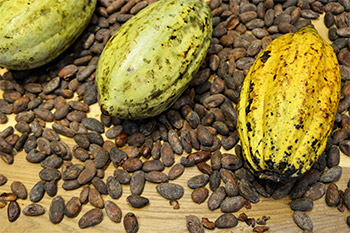 Cacoa Bean Processing
Cacoa Bean Processing
Cacao is the bean from the cacao tree. Once the cacao beans are processed, they’re often called cocoa.
Processing the cacao fruit is quite extensive. It begins with hand harvesting the ripe cacao pods. The pods are the fruit of the tree and are similar in size and shape of a football. Once harvested, the cacao pods are opened and the beans removed. After removal, the beans are fermented to stop germination and to initiate flavor development. The beans are then dried and sorted prior to going to the processing plant. At the processing plant the beans are roasted which creates a darker cacao color and promotes flavor enhancement. Once roasted, the shell surrounding the bean is removed and the cacao nib remains. The cacao nib is the base ingredient for making chocolate. The nib can be ground into a paste to create chocolate liquor which is used in chocolate bars. If processed further, the fat is removed to produce cocoa butter used in beauty products and chocolate bars. This leaves the cacao presscake which is milled into cocoa powder used in baking and hot cocoa.
Description & Health Benefits
- The cacao bean is included in the botanical family Malvaceae.
- The cacao bean is grown on the cacao tree, otherwise known as Theobroma cacao.
- Cocoa powder is an excellent source of fiber, magnesium, copper, and manganese, and a good source of iron
and phosphorus.- Fiber helps regulate digestion by preventing constipation.
- Magnesium plays many roles in the body, including regulation of countless biochemical processes such as protein synthesis, function of muscles and nerves, and regulation of blood pressure and blood glucose.
- Copper aids in red blood cell formation, iron absorption, energy production, and connective tissue formation.
- Manganese plays a role in fat and carbohydrate metabolism, calcium absorption and blood sugar regulation.
- Iron is essential for growth, development and red blood cell formation, and is also needed to create some hormones and connective tissue.
- Phosphorus promotes formation of bones and teeth, assists in kidney function, muscle contraction and a
normal heartbeat.
Purchasing, Selecting, Storing, and Preparing Cacao Bean
- Purchase a variety of cocoa products at the store such as chocolate bars, cocoa powder, hot chocolate, baking chocolate, etc.
- Select product within its expiration date. For example cocoa powder typically has a shelf life of 2-3 years once opened.
- Store and prepare according to specific directions in recipe or on product.
Nutrition Facts
Cocoa powder, unsweetened, 1/4 cup
Calories: 49 | Protein: 4.21 g | Fat: 2.95 g | Carbohydrate: 12.45 g | Fiber: 8.0 g | Calcium: 28 mg | Magnesium: 107 mg | Potassium: 328 mg | Folate: 7 μg
Baking chocolate, unsweetened 1/4 cup, grated
Calories: 212 | Protein: 4.73 g | Fat: 17.26 g | Carbohydrate: 9.38 g | Fiber: 5.5 g | Calcium: 33 mg | Magnesium: 108 mg | Potassium: 274 mg | Folate: 9 μg
ndb.nal.usda.gov
Recipes
Request an Appointment
